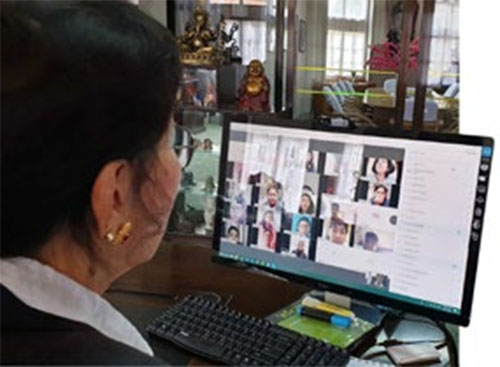Holding virtual classes: Not as easy as it looks
Kathmandu
One of the sectors that has been greatly impacted by COVID-19 lockdown is education.
Online learning has been considered an alternative in this situation and as such many educational institutions have started online classes.
Gyanodaya Bal Batika School started its virtual classes for students from Class I to X more than a week ago after a few days of planning and training of teachers.
The online classes are scheduled from Monday to Friday, 9:00 am to 12:00 noon, or more if needed. All subjects are being taught to seniors (Class VIII to X), while junior classes like Class I and II are being taught language, artwork and little bit of Maths and Science.
“We are lucky that we are wellequipped here — digital literacy was a part of our curriculum, and so the teachers and students have been guided in that way,” shares Bhanu A, Senior Vice-Principal of Gyanodaya. He feels online classes have been quite effective, but it has not been as easy as it looks.
Online education solely depends on Internet. Access to Internet to its fluctuating connectivity can mar the smooth running of the classes as well as attendance.
“Getting 100 per cent attendance is difficult,” Bhanu A shares. As per him, a few of their students come from remote areas and they don’t have access to the Internet. They have sought another way to engage such students — they send required links of educational material and assignments through Whatsapp rather than live classes.
As per him, using digital literacy is the thing for the present generation. They even faced a little bit of resistance from teachers who are not digitally literate. “It is difficult for them to transit to the digital world, but they have tried,” he says.
However the effectiveness of online classes depends on students’ access to it.
“We have tried online classes but not all of our students have access to Internet, and the required devices like mobile phones or laptop or cannot afford them,” says Meenakumari Koirala Pokharel, Principal, Padmodaya Secondary School, Putalisadak.
The school is now running two-hour online classes on Maths and Computer for SEE-appearing students through Zoom.
As per her, only about half the number of students out of 60 SEE-appearing students are attending the classes; she hopes the number increases.
“Most students in community schools like ours cannot afford facilities like expensive mobile phones and Internet. And some of our students have gone to their villages with no Internet access,” she explains.
Twenty-one-year-old Ratna Gupta, a BBA student of a management college in Dhobighat, started learning through online classes two weeks ago.
Attending online classes from Janakpur, she says she is benefitting from it. She missed a first few classes as “I didn’t have Internet at home then”.
Now she has been attending the classes regularly. Her online classes include teaching-learning of two subjects per day, one-and-half-hour class each, from Sunday to Friday.
But it is not without technical glitches among other challenges.
Zoom has 45-minute limitation for each session (class) after which the teacher has to restart the class, while students have to rejoin the class. Sometimes some students go offline in the middle of class due to poor connection.
Eleven-year-old daughter of Jermit Yong Rana is also studying online. At the beginning of week her daughter is sent links of the study materials of different subjects through her school app along with respective assignments.
The assignments have to be submitted by Saturday.
“Children will be familiar with courses and academics if they are engaged in their schoolwork for a few hours,” shares Rana, who guides her daughter when needed.
While online learning is helpful at present due to the lockdown “it cannot be a substitute for classroom education,” as per Bhanu A. He cites life skills and social skills can’t be achieved through virtual classes.
Pokharel deems online classes limited to disseminating of information, reading and writing. “We wouldn’t know how students are studying,” she adds.
On a brighter note, Pokharel says they are getting to know what online class is like, something they had only heard of before the lockdown. “We can use this way even during regular classes,” she adds.
A version of this article appears in e-paper on May 5, 2020 of The Himalayan Times.






